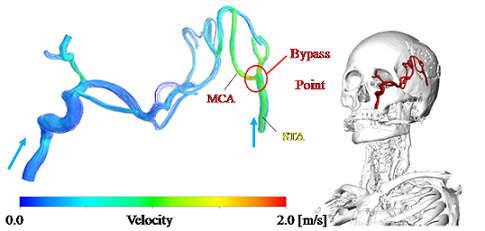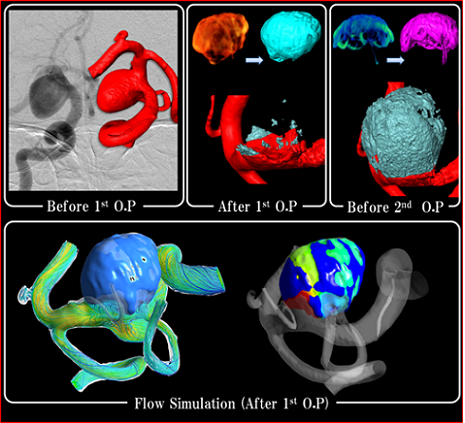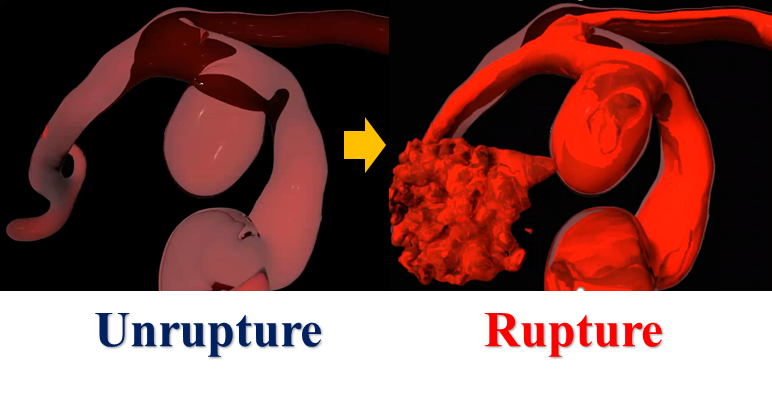Medical Engineering(The Jikei University)
1.Blood Flow Analysis of STA-MCA Anastomosis Using CFD

Cerebral infarction is the most deceased among cerebrovascular diseases known as the fourth leading cause of death in the Japanese. One of the surgical treatments for cerebral infarction is cerebrovascular bypass surgery. However, in Japan today there is no definite view on its usefulness, and discussion is ongoing. In this study, we are focusing on shallow temporal artery - middle cerebral artery anastomosis (STA - MCA bypass surgery) which is one of cerebrovascular bypass surgery. This is an operation that connects (anastomoses) STA, which is the artery that nourishes the scalp, to MCA, a blood vessel in the brain. By reproducing the vascular lumen shape of each patient from the photographed medical image and numerically calculating the blood flow flowing in the cerebral blood vessel of the patient who underwent STA-MCA bypass surgery, it is possible to calculate the blood flow dynamics before and after the operation I will explore the change. By doing preoperative CFD analysis in the future, we aim to make it possible to investigate optimal surgical conditions before the operation.
2.Investigation on Risk Facors for Cerebral Aneurysm Recanalization

There is a disease called cerebral aneurysm in cerebrovascular disease which is one of the main cause of death of the Japanese. If the cerebral aneurysm ruptures, there is a possibility that it will cause subarachnoid hemorrhage. Subarachnoid haemorrhage is a dangerous disease that about 30% of the onset is dead on the spot. Therefore, when an aneurysm is found, it must be treated in an unruptured state. In recent years, coil embolization surgery has been widely used to treat unruptured cerebral aneurysms. Coil embolization is a procedure that prevents blood invasion into the aneurysm by placing the coil inside the aneurysm using a catheter and thrombusizing it. This technique has merit that it is less invasive (less physical burden) compared with clipping technique that performs craniotomy, while coil compaction, in which the placed coil is compressed in the aneurysm and becomes smaller, and an aneurysm Blood has flowed into the aneurysm again due to growth and so on, and a lot of cases are forced to reoperate. This phenomenon is called reopening, and it is a problem that can occur due to the technique called coil embolization. Currently, the precise mechanism of reopening occurrence has not been elucidated, the coil filling method has been decided by the doctor's subjective judgment, establishment of objective judgment criteria is required. In this study, the flow in the vascular system is reproduced by numerical fluid dynamics by using angiography images by digital subtraction angiography (DSA) and coil images. This research aims to elucidate factors causing reopening and to propose concrete indices at the time of treatment effective to prevent reopening.
3.Identification of growth factors of cerebral aneurysms

The cerebral aneurysm gradually grows due to the influence of the blood flow, and a thin part (thin part) is formed on the wall of the cerebral aneurysm, and it is pointed out that there is a possibility of rupture from that part. Caused by the growth of cerebral aneurysms, the causes of the thinner part are, for example, that the aneurysm wall is strongly pulled by blood flow, blood collides against a certain point on the wall and impacts the wall It is conceivable. If it is possible to identify factors related to the growth of cerebral aneurysm and to identify the thin portion, it will be possible not only to perform treatment before the cerebral aneurysm ruptures, but also to be able to perform treatment before rupture during coil embolization It also helps to reduce the risk of. We analyze the blood flow in the cerebral aneurysm using CFD, identify the growth factors and the thin part of the cerebral aneurysm, and realize the safer treatment of the cerebral aneurysm by identifying cases of surgical indication.
4.Prediction of rupture of cerebral aneurysm

About 30% of people who developed subarachnoid hemorrhage died on the scene, leaving severe aftereffects even when escaping death, it is very dangerous disease that often becomes bedridden. Rupture of the cerebral aneurysm may cause such subarachnoid hemorrhage. A cerebral aneurysm is a type of cerebrovascular disease that becomes a bag shape as the wall surface of a cerebral blood vessel bulges, and in recent years it is possible to detect an unruptured cerebral aneurysm at an early stage due to the spread of brain docks and development of angiography. Surgery to prevent the rupture of an unruptured aneurysm requires clipping surgery by craniotomy or coil embolization with less physical burden on the body (minimally invasive), but both require risk and cost burden for patients, the mental burden will be great. Furthermore, cerebral aneurysms do not necessarily rupture at all, and their burst rate is said to be about 1%, so many patients are unable to undertake surgery. Regarding the judgment of surgery, it is currently the case that most doctors have made it through experience. Therefore, if it is possible to numerically evaluate the aneurysm rupture prediction, it will be possible to save many patients suffering from cerebral aneurysms. In this study, we analyze blood flow in the cerebral artery using CFD, investigate factors involved in rupture of the cerebral aneurysm, and aim to predict rupture of the cerebral aneurysm.
5.Numerical study on treatment of cerebral aneurysm using Flow Diverter stent
In recent years, a cerebral aneurysm is a cerebral aneurysm, by placing a stent Flow Diverter on the neck of a cerebral aneurysm, it is possible to change the blood flow, prevent the blood flow into the aneurysm, It is done. However, with regard to this treatment, it is not clear what type of stent will be the best treatment, and patients who have ruptured and have died after treatment have been reported. We collaborated with Neurosurgical Department at Jikei University Hospital and conducted fluid analysis using patient-specific cerebral aneurysm shape and structural analysis on stent, so that the effects on the blood flow and the structural mechanical properties of the stent we are evaluating. It aims to make it possible to clarify the change and the risk of blood flow dynamics by indwelling stent, preoperative evaluation of stent treatment for individual patient, and selection of optimum FD for individual patient.
